Kickstart your journey towards harmony and balance by learning to Feng Shui your living room; read more to unravel the magic!
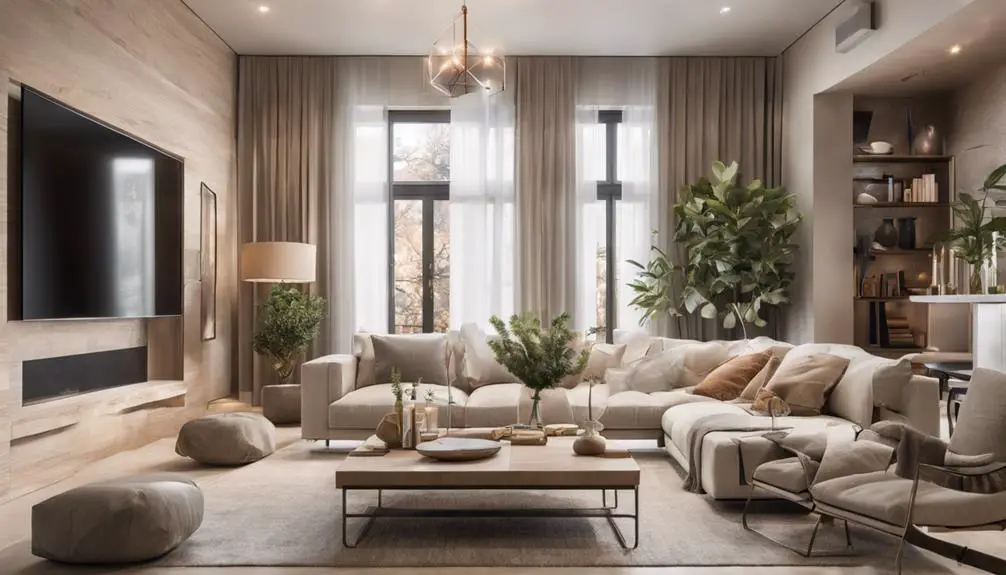
How to Feng Shui Living Room
Isn't it intriguing how the ancient art of Feng Shui can transform your living room into a sanctuary of harmony and balance?
You're about to discover how to identify your room's energy map and use it to guide your furniture selection and arrangement.
The right color palette, along with a few carefully chosen decor elements, can significantly enhance the positive energy flow in your space.
But how exactly do you achieve this balance? Let's unravel this mystery together, step by step.
Key Takeaways
- Use the bagua grid to divide your living room into nine sections, optimizing energy flow and reflecting life aspirations.
- Select furniture made of natural materials and arrange it in a circular pattern to facilitate positive energy movement.
- Choose a color palette that resonates with the room's energy and mood, using colors that represent the five elements.
- Incorporate a variety of Feng Shui decor elements, including different textures and living plants, to balance the energy and create a harmonious ambiance.
Understanding Basic Feng Shui Principles
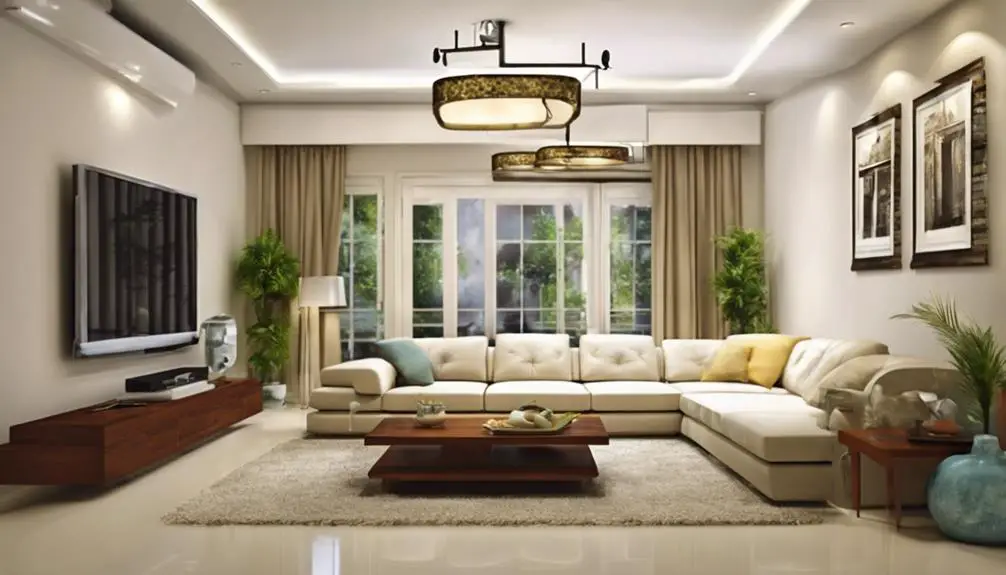
To truly harness the power of Feng Shui in your living room, you'll need to first grasp the core principles that underpin this ancient art. Feng Shui's origins trace back to ancient China, where it was believed that the arrangement and orientation of space could impact the flow of energy, or 'chi'. This energy, when balanced, was said to foster harmony and prosperity.
Understanding the concept of 'Balancing Elements' is fundamental to Feng Shui. This principle revolves around the five elements, namely, Wood, Fire, Earth, Metal, and Water. Each element represents a certain aspect of life and nature. Wood symbolizes growth and vitality, Fire denotes warmth and transformation, Earth stands for stability and balance, Metal signifies clarity and precision, and Water represents wisdom and serenity.
Balancing these elements in your living room isn't about literally incorporating each one, but about using colors, shapes, and materials that symbolize them. For example, incorporating blues and blacks, or fountains and mirrors, can represent the Water element. It's all about creating a harmonious energy flow that resonates with your life goals and personal style. By understanding these core principles, you'll be well equipped to Feng Shui your living room.
Identifying Your Living Room's Energy Map
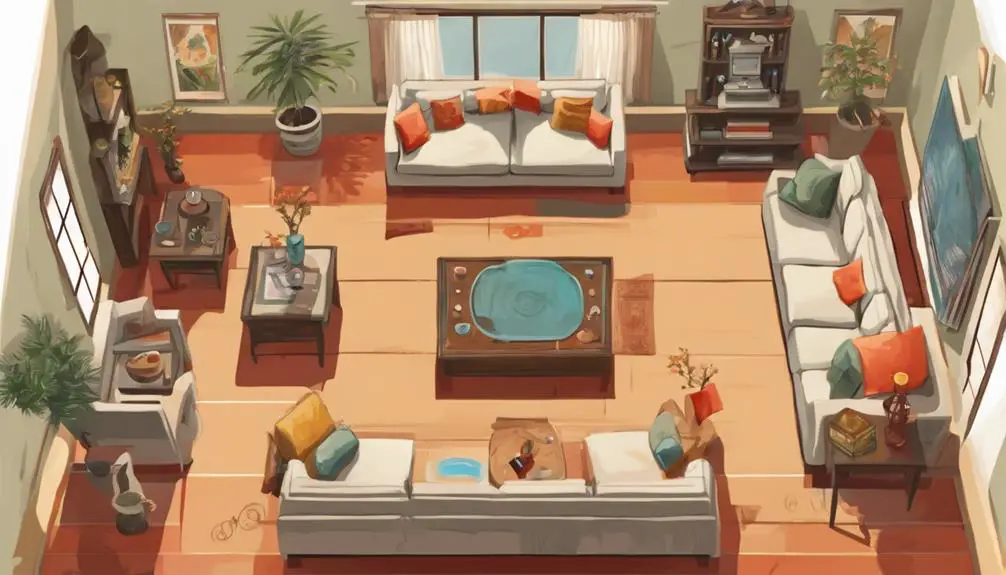
Once you've grasped the core principles of Feng Shui, the next step is identifying the energy map, or 'bagua', of your living room, which serves as a blueprint for arranging your space to enhance chi flow. The energy map basics involve dividing your space into nine equal sections, each representing different aspects of life like wealth, health, love, and career.
Start by sketching your living room's floor plan. Then overlay it with the bagua grid. Each section of the grid corresponds to a unique life aspect. Your task is to harmonize your living room with these energies through mindful arrangement and decoration.
The room orientation impact is significant in Feng Shui. The main entrance to the living room is the reference point for aligning the bagua map. From here, the far left corner is considered the wealth area, while the far right corner is linked to love and relationships.
Understanding your living room's energy map isn't about rigidly following all the rules. Instead, it's about understanding the flow of energy and creating a balanced, harmonious space. The goal is to enhance the positive energy in your life. Your living room, after all, should be a reflection of your life's aspirations.
Selecting and Arranging Furniture
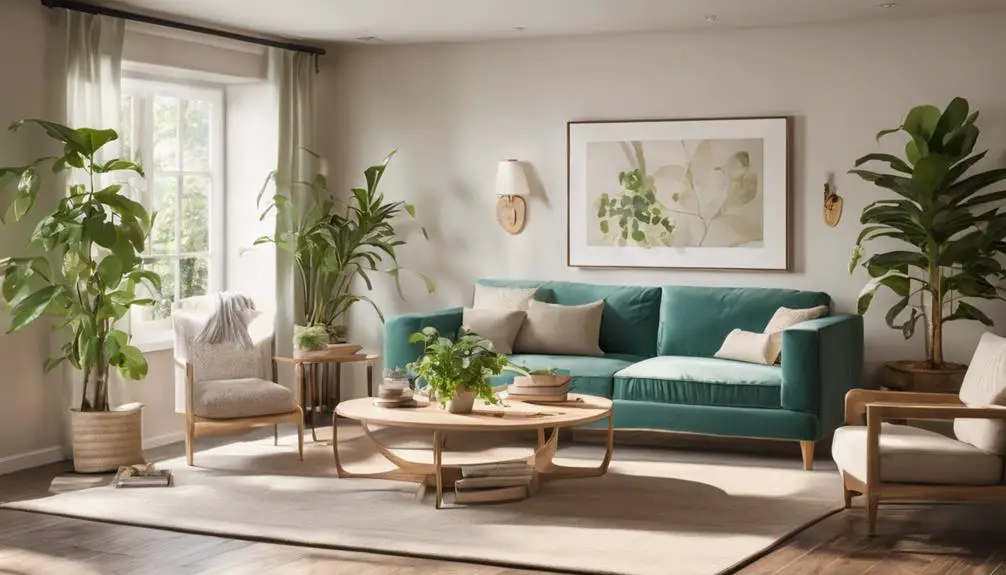
With your living room's energy map in mind, you're ready to make informed decisions about selecting and arranging your furniture to further enhance the chi flow. Material selection plays a key role in this process. Opt for natural materials like wood, which symbolize growth and vitality in Feng Shui, contributing to a positive energy flow. Cushions made from organic fabrics like cotton or silk can also boost the room's chi.
Comfort consideration is another crucial aspect to bear in mind. Your living room should be a haven of relaxation, so choose furniture that provides maximum comfort. An oversized sofa or a recliner chair might be just what you need to create a cozy, inviting ambiance. However, don't overcrowd the space – Feng Shui emphasizes the importance of balance and simplicity.
When arranging the furniture, focus on creating a harmonious arrangement. Avoid placing furniture in a straight line with the door, as this can disrupt the chi flow. Instead, try to arrange your furniture in a circular or octagonal pattern. These shapes encourage the movement of energy, creating a living room that's not only stylish, but also a beacon of positive energy.
Choosing the Right Color Palette
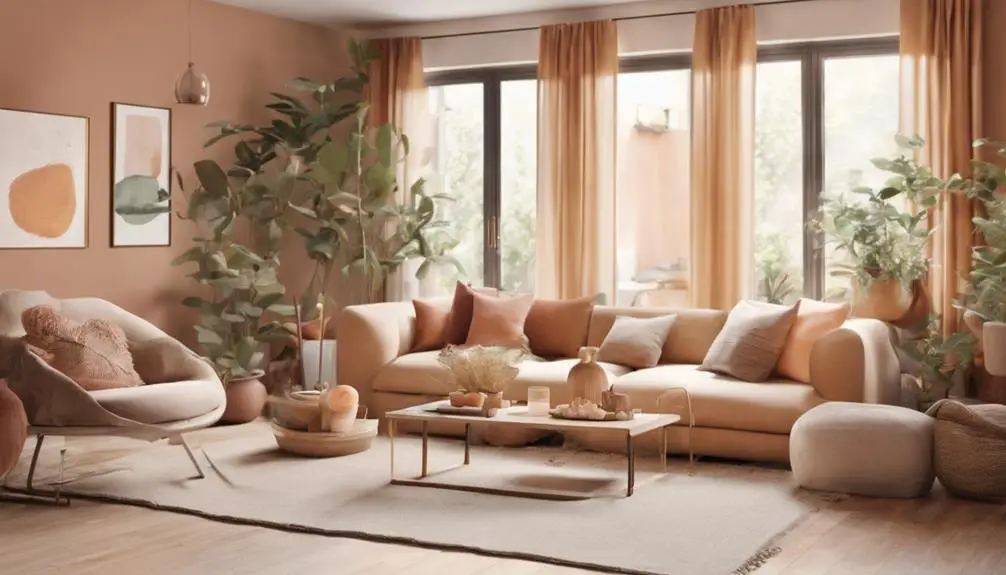
Equally as important as furniture arrangement, your choice of color palette can significantly impact the overall energy and mood in your living room. Color symbolism in feng shui plays a vital role in harmonizing your living space. Each color represents one of the five elements – wood, fire, earth, metal or water – that influence the ambiance and energy flow.
Red, for example, embodies fire and passion, perfect for sparking lively conversations. Blues and blacks, on the other hand, symbolize water, promoting a peaceful and calming environment. Greens, which represent wood, can encourage growth and rejuvenation.
However, it's not just about selecting a color; it's about understanding the impact of light on colors. Light can change the appearance and energy of a color. Bright, natural light can make a deep blue seem vibrant and energetic, while dim light can make the same color feel somber and quiet.
Incorporating Feng Shui Decor Elements

Beyond selecting the right colors, you'll also want to consider the types of decor elements you integrate into your living room to further enhance the feng shui. Balancing decor elements is crucial to creating harmony in your space. Start by introducing a variety of shapes and materials, such as wood, metal, and soft fabrics, to promote a seamless flow of energy.
For instance, you might pair a sleek, metal coffee table with a soft, plush rug. These contrasting textures create balance, allowing the positive chi to circulate freely around the room. Don't shy away from adding living elements, such as plants, which inject vitality and promote a sense of tranquillity.
Emphasizing natural light is another key aspect of feng shui decor. Arrange your furniture to maximize the daylight that floods in. Avoid heavy, dark curtains and instead opt for light, airy ones that allow sunshine to permeate the room. Mirrors strategically placed can also amplify the light and create an illusion of more space.
Frequently Asked Questions
What Specific Plants Are Recommended for a Feng Shui Living Room?"
You're wondering about specific plants for your space?
Well, using plant placement techniques, the optimal plant types are those with rounded leaves like a jade plant. Money plants are also recommended due to their association with prosperity.
For a touch of color, consider a blooming orchid.
How Does the Size and Shape of the Living Room Affect the Feng Shui?"
The size and shape of your room greatly influence its energy flow. In Feng Shui, the room's orientation affects the energy's direction while furniture placement can either enhance or obstruct it.
Large, square rooms offer balanced energy flow. If your room's shape is irregular, you'll need to cleverly arrange furniture to ensure positive energy distribution. Remember, balance is key.
Properly applying these Feng Shui principles will create a harmonious living space.
Are There Any Feng Shui Principles Specifically for Living Rooms in Apartments?"
Yes, there are specific Feng Shui principles for apartments. It's crucial to focus on your apartment layout and furniture arrangement. Ensure your furniture doesn't block any doors or windows, promoting good energy flow. Keep the living room clutter-free, as clutter hinders positive energy.
Also, consider the balance of the five elements: wood, fire, earth, metal, and water. Remember, Feng Shui is about creating harmony in your space, regardless of whether it's a house or an apartment.
How Can I Balance the Five Elements in a Small Living Room?"
Balancing the five elements in a small living room can be simple with smart element arrangement and color selection. You'll want to incorporate wood, fire, earth, metal, and water elements. Use colors as representations like green for wood or red for fire.
Arrange furniture to allow free-flowing energy. Be creative with your décor, maybe a metal sculpture or a water fountain. Remember, it's about creating harmony.
Even in small spaces, you can achieve balance.
How Does Feng Shui Relate to the Overall Architecture of the House?"
Feng Shui directly influences your home's architecture. It's not just about the room's layout, but also Feng Shui colors and room entrance positioning.
You're creating a harmonious flow of energy. So, consider the entrance position, as it affects energy flow. Also, using the right colors can balance energies. It's not just about aesthetics, but also the feeling of peace and balance.
Conclusion
In revamping your living room, remember Feng Shui is all about balance and harmony. Recognize your room's energy map, select furniture with mindfulness, and settle on a color palette that soothes. Incorporate décor that aligns with Feng Shui principles.
Don't stress; it's a journey, not a destination. Take one step at a time and watch your living room transform into a sanctuary of peace and positivity, radiating good vibes in every corner.

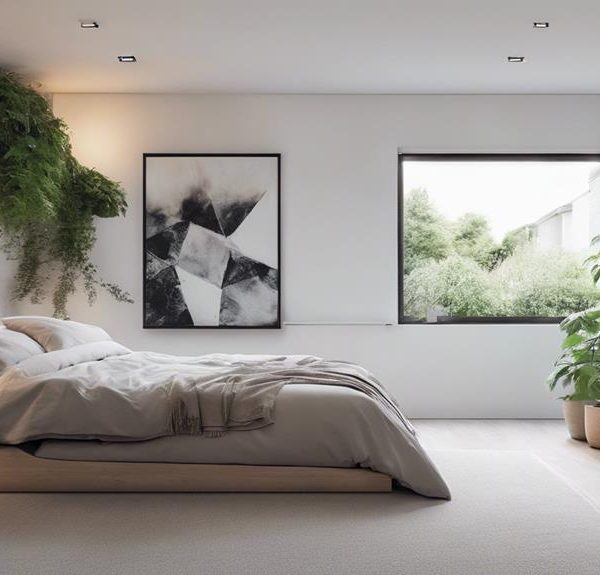
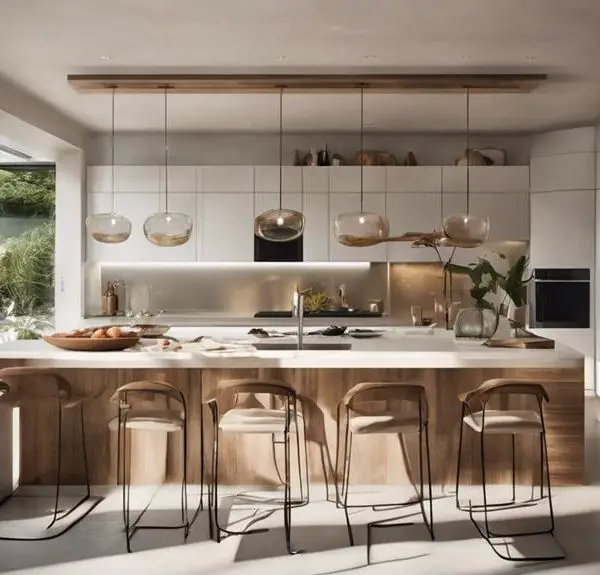
Sign up